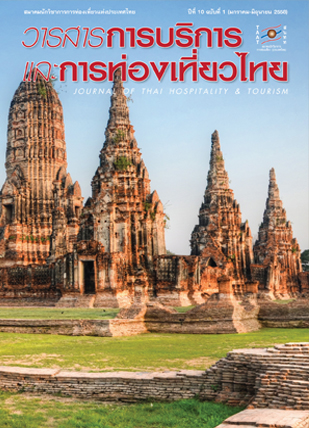Tourism : Dawei Tanintharyi Territory of the Republic of the Union of Myanmar
Main Article Content
Abstract
This is a study of Dawei's potential as a new tourist destination in Myanmar. The study was conducted using qualitative data obtained through structured interviews and its accuracy was verified using Tri-angular checking. Five cultural sections were included in the study: (1) Nine significant temples, (2) Seaside Fish Markets and Villages, (3) Dawei's Museum (which was opened purpose by for tourism), (4) Three different one hundred year old markets, and (5) Special events such as the 28 Pagoda festival (an event which occurs during the full moon after the end of the rainy season) and the Dawei water dance for example.
Article Details
How to Cite
Sangnak, D. (2015). Tourism : Dawei Tanintharyi Territory of the Republic of the Union of Myanmar. Journal of Thai Hospitality and Tourism, 10(1), 3–14. retrieved from https://so04.tci-thaijo.org/index.php/tourismtaat/article/view/35503
Section
Research Article
References
[1] กนกวรรณ มะโนรมย์. (2552). พัฒนาการและการขยายตัวของเมืองชายแดน: กรณีศึกษาเมืองโขงเจียมจังหวัดอุบลราชธานี. อุบลราชธานี: มหาวิทยาลัยอุบลราชธานี.
[2] กฤษณียา ศังขจันทรานนท์ และคณะ. (2550). โครงการแหล่งท่องเที่ยวธรรมชาติแบบผจญภัยในอีสานใต้. กรุงเทพ: สํานักงานกองทุนสนับสนุนการวิจัย (สกว.).
[3] โฉมยง โต๊ะทอง. (2554). โครงการ ASEAN: การเรียนรู้ข้ามวัฒนธรรมผ่านหลักสูตรท่องเที่ยวในกลุ่มประชาคมเศรษฐกิจอาเซียนกรณีศึกษาประเทศไทย. กรุงเทพฯ: สํานักงานกองทุนสนับสนุนการวิจัย (สกว.).
[4] นิคม จารุมณี. (2536). การท่องเที่ยวและการจัดการอุตสาหกรรมท่องเที่ยว. กรุงเทพฯ: โอ.เอส.พริ้นติ้งเฮ้าส์.
[5] พิพัฒน์ นนทนาธรณ์ และคณะ. (2555). ศึกษาความเหมาะสมการจัดตั้งด่านศุลกากรณบ้านพุนํ้าร้อนอําเภอเมืองจังหวัดกาญจนบุรี. กรุงเทพ: มหาวิทยาลัยเกษตรศาสตร์.
[6] Allen, J., Smith, A. J. and Smith. (2011, December 1). Myanmar (Burma) Travel Guide. Lonely Planet: The World’s Leading Travel Guide Publisher.
[7] Arreola, D. D. and Curtis, J. R. (1993). The Mexican Border Cities: Landscape Anatomy and Place Personality. Tucson: University of Arizona press.
[8] Arreola, D. D. and Madsen, K. (1999). Variability of Tourist Attractiveness along An International Boundary: Sonora, Mexico Border Towns. Visions in Leisure and Business. 17(4), 19-31.
[7] Borneman, J. (1998). Grenzregime (Border Regime): The Wall and its Aftermath, In T. M. Wilson and H. Donnan (eds) Border Identities: Nation and States at International Frontiers (pp.162-190). Cambridge: Cambridge University Press.
[8] Elkins, T. H. and Hofmeister, B. (1988). Berlin: The Spatial Structure of a Diveded City. Methuen, London and New York.
[9] Essex, S. J. and Gibb, R.A. (1989). Tourism in the Anglo-French Frontier Zone. Geography. 74(3), 222-231.
[10] Goeldner, R. and Ritchie, J. R. B. (2006). Tourism: Principles, Practices, Philosophies. Hoboken: John Wiley and Sons, Inc.
[11] Hidalgo, L. (1993, November 22). British Shops Suffer as “Booze Cruise” Bargain Hunters Flock to France. The Times, p.5.
[12] Koenig, H. (1981). The Two Berlins. Travel Holiday. 156(4), 58-63; 73-80.
[13] Light, D. (2000). Gazing on Communism: Heritage Tourism and Post-communist Identities in Germany, Hungary and Romania. Tourism Grographies. 2(2), 157-176.
[14] Lintner, B. (1991, May 16). Upstaging Macau: Casino at Centre of Border Development Plan. Far Eastern Economic Review, p.24.
[15] Nieves, E. (1996, December 15). Casio Envy Gnaws at falls on US Side. New York Times, p.49.
[16] Peisley, T. (1987). Sea Ferry Travel and Short Cruises. Travel and Tourism Analyst. 1, 19-29.
[17] Smith, G. J. and Hinch, T. D. (1996). Canadian Casinos as Tourist Attrations: Chasing the Pot of Gold. Journal of Travel Research. 34(3), 37-45.
[18] Stern, E. (1987). Competition and Location in the Gaming Industry: The Casino States’ of Southern Africa. Geography, 72(2), 140-150.
[19] Timothy, D. J. (1995). Political Boundaries and Tourism: Borders as Tourist Attractions. Tourism Management, 16(7), 525-532.
[20] Williams, A. A. and Balaz, V. (2000). Tourism in Transition: Economic Change in Central Europe. London: I.B. Tauris.
[2] กฤษณียา ศังขจันทรานนท์ และคณะ. (2550). โครงการแหล่งท่องเที่ยวธรรมชาติแบบผจญภัยในอีสานใต้. กรุงเทพ: สํานักงานกองทุนสนับสนุนการวิจัย (สกว.).
[3] โฉมยง โต๊ะทอง. (2554). โครงการ ASEAN: การเรียนรู้ข้ามวัฒนธรรมผ่านหลักสูตรท่องเที่ยวในกลุ่มประชาคมเศรษฐกิจอาเซียนกรณีศึกษาประเทศไทย. กรุงเทพฯ: สํานักงานกองทุนสนับสนุนการวิจัย (สกว.).
[4] นิคม จารุมณี. (2536). การท่องเที่ยวและการจัดการอุตสาหกรรมท่องเที่ยว. กรุงเทพฯ: โอ.เอส.พริ้นติ้งเฮ้าส์.
[5] พิพัฒน์ นนทนาธรณ์ และคณะ. (2555). ศึกษาความเหมาะสมการจัดตั้งด่านศุลกากรณบ้านพุนํ้าร้อนอําเภอเมืองจังหวัดกาญจนบุรี. กรุงเทพ: มหาวิทยาลัยเกษตรศาสตร์.
[6] Allen, J., Smith, A. J. and Smith. (2011, December 1). Myanmar (Burma) Travel Guide. Lonely Planet: The World’s Leading Travel Guide Publisher.
[7] Arreola, D. D. and Curtis, J. R. (1993). The Mexican Border Cities: Landscape Anatomy and Place Personality. Tucson: University of Arizona press.
[8] Arreola, D. D. and Madsen, K. (1999). Variability of Tourist Attractiveness along An International Boundary: Sonora, Mexico Border Towns. Visions in Leisure and Business. 17(4), 19-31.
[7] Borneman, J. (1998). Grenzregime (Border Regime): The Wall and its Aftermath, In T. M. Wilson and H. Donnan (eds) Border Identities: Nation and States at International Frontiers (pp.162-190). Cambridge: Cambridge University Press.
[8] Elkins, T. H. and Hofmeister, B. (1988). Berlin: The Spatial Structure of a Diveded City. Methuen, London and New York.
[9] Essex, S. J. and Gibb, R.A. (1989). Tourism in the Anglo-French Frontier Zone. Geography. 74(3), 222-231.
[10] Goeldner, R. and Ritchie, J. R. B. (2006). Tourism: Principles, Practices, Philosophies. Hoboken: John Wiley and Sons, Inc.
[11] Hidalgo, L. (1993, November 22). British Shops Suffer as “Booze Cruise” Bargain Hunters Flock to France. The Times, p.5.
[12] Koenig, H. (1981). The Two Berlins. Travel Holiday. 156(4), 58-63; 73-80.
[13] Light, D. (2000). Gazing on Communism: Heritage Tourism and Post-communist Identities in Germany, Hungary and Romania. Tourism Grographies. 2(2), 157-176.
[14] Lintner, B. (1991, May 16). Upstaging Macau: Casino at Centre of Border Development Plan. Far Eastern Economic Review, p.24.
[15] Nieves, E. (1996, December 15). Casio Envy Gnaws at falls on US Side. New York Times, p.49.
[16] Peisley, T. (1987). Sea Ferry Travel and Short Cruises. Travel and Tourism Analyst. 1, 19-29.
[17] Smith, G. J. and Hinch, T. D. (1996). Canadian Casinos as Tourist Attrations: Chasing the Pot of Gold. Journal of Travel Research. 34(3), 37-45.
[18] Stern, E. (1987). Competition and Location in the Gaming Industry: The Casino States’ of Southern Africa. Geography, 72(2), 140-150.
[19] Timothy, D. J. (1995). Political Boundaries and Tourism: Borders as Tourist Attractions. Tourism Management, 16(7), 525-532.
[20] Williams, A. A. and Balaz, V. (2000). Tourism in Transition: Economic Change in Central Europe. London: I.B. Tauris.


